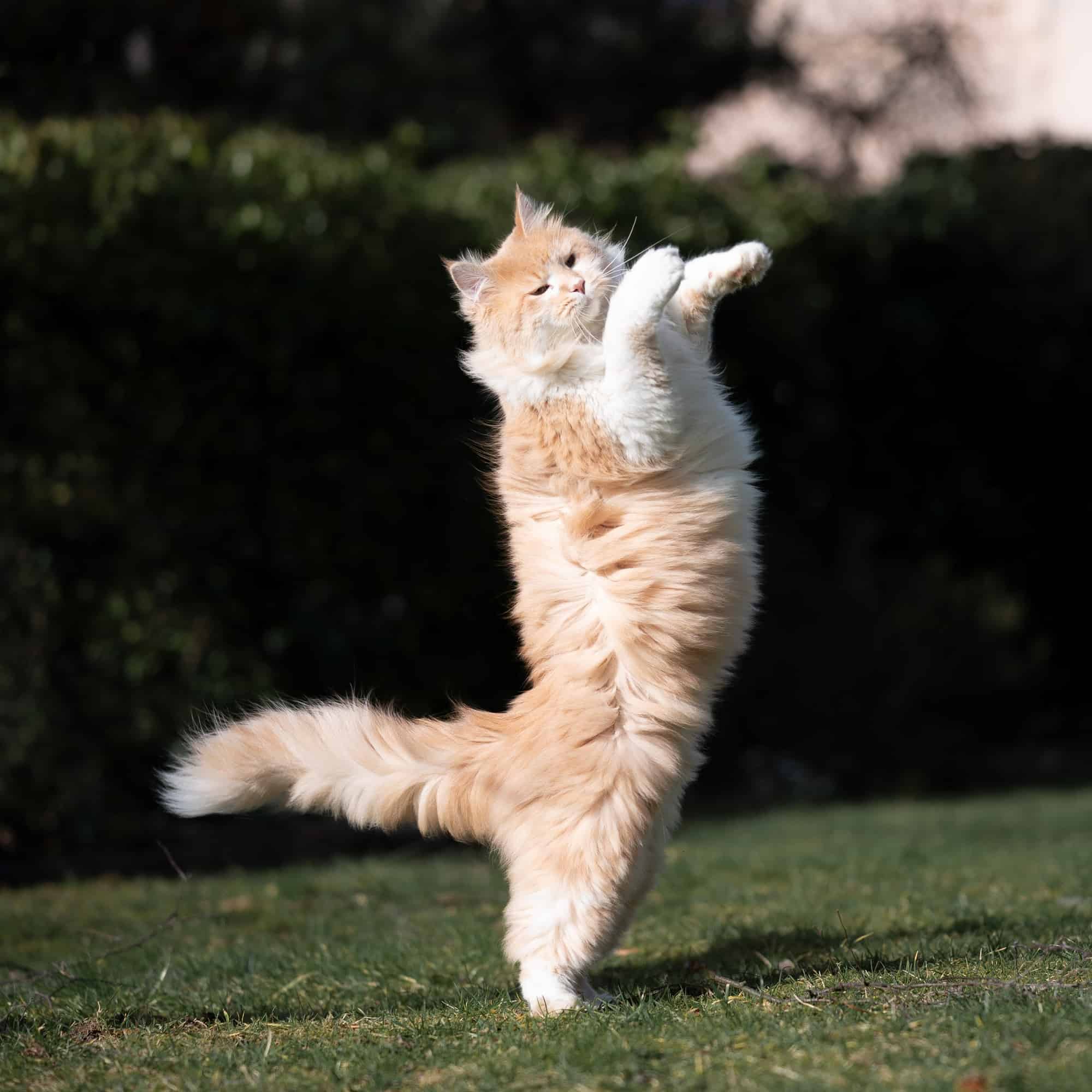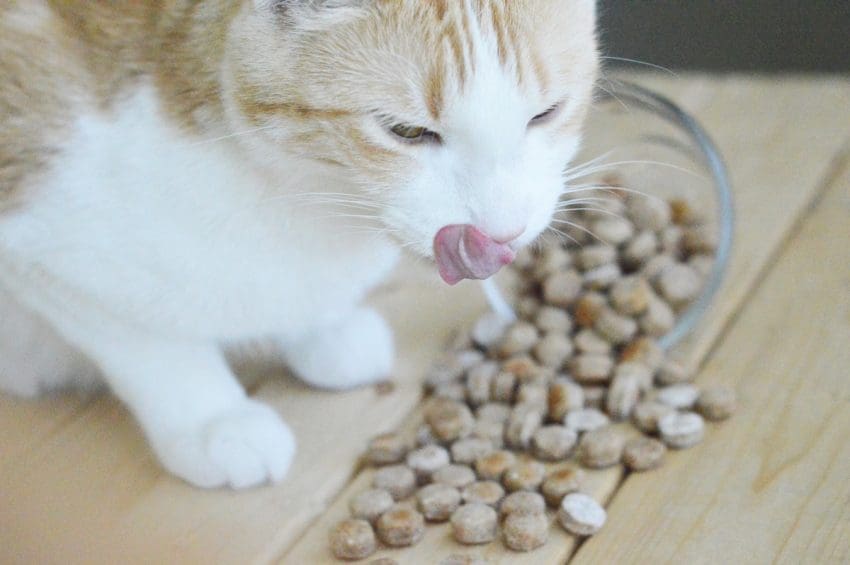Last Updated: 9 mins ago
How do I train my cat to stand on his hind legs?
It’s a question that we see on cat owner message boards from time to time, and it’s easy to see why!
We’ve all seen those photos and funny videos of cats standing up and begging for food or rising up for a head boop.
So in this article, we’ll find out how to turn our own kitties into superstars by teaching them this neat trick.
How Do I Train My Cat to Stand on His Hind Legs?
It’s not surprising that so many people want to know how to train a cat to stand on his hind legs!
It really is an adorable trick, isn’t it?
We can teach our cats to do this with a little training and positive reinforcement.
First, though, we need to understand how training works.
Understand How Training Works
Before you can master training your cat to stand up on his hind limbs, it’s key to understand animal behavior.
When you understand the way their brains work, it makes it so much easier to understand the training process in general.
So first and foremost, I want to be sure this article teaches you about this process.
Animal Behavior
All animals operate on a reward system, even wild animals. When a wild animal makes a kill or finds some other food source, they are rewarded by eating.
Shelter rewards them with safety. An impressive display rewards them with a mate.
For domesticated animals, their reward tends to be special treats. Animal behavior dictates that the better the reward, the more rewarding it is.
So while food is something your cat always has access to, those extra special treats probably aren’t as readily available.
Positive Reinforcement
Positive reinforcement is another key part of training any animal. Unlike people, animals can’t understand negative reinforcement. It should never be used.
Never yell, discipline, or otherwise give your cat negative feedback when teaching him to do anything.
This is an issue that comes up when people are new to training their animals.
They assume that focusing on the failures is just as important as rewarding the successes, but that isn’t true.
Instead, ignore failures and thoroughly reward successes.
Negative reinforcement, also called punishment, only stresses out our cat, potentially making him fearful of you.

Repetition
Repetition is another key part of pet training. Dogs, cats, and other pets need repetition to master a skill.
Just as a person needs to practice anything to become proficient at it, cats need repeated training sessions to master any command.
The number of times your cat gets a treat for standing up is directly related to his mastery of the behavior.
Start Early
Kittens are little sponges, and they soak up information readily.
Breeds don’t matter that much when it comes to ease of training, although some cats, like Maine Coons, pick up training faster.
The main thing in training is starting early.
An adult cat can become set in his ways. Starting training early helps ensure that your kitten is willing to try new things.
This saves you the headache of the slow grind that can sometimes happen when trying to train an adult cat.
You can begin training your kitten in very short time periods early on.
In fact, with cats, earlier is better to ensure that they learn to be well-behaved and don’t develop any avoidable behavioral issues.
Pet Training Supplies
All training sessions should be a positive experience.
To that end, your training supplies are going to be those that make the experience the most enjoyable for your cat.
Your two go-to’s for pet training are going to be treats and a clicker.
Clickers help your cat understand exactly how and why his treat is connected to executing the command he’s been giving.
Using it in conjunction with giving the treat is a one-two punch for training.
The click marks the desired behavior, so your cat associates the click with the action.
The treat is the reward for performing the action—in this case, rising up on his hind limbs.
So when used together, your cat knows the click means he did the right thing and that a treat is coming.
How Do I Train My Cat to Stand on His Hind Legs?
Your outdoor cat is just as capable of learning to stand up as indoor cats are.
Many people think that it’s harder to train an outdoor cat because they’re more independent, but that’s not an issue.
If you remember that an animal’s brain works off of the reward system mentality we just talked about, you’ll remember that all animals operate on that reward system.
Your outdoor cat will be just as receptive to treats as an indoor cat.

Gather Your Supplies
To ensure productive training sessions, it’s important that you have all of your supplies ready to go.
Gather your clicker and your treats.
Be sure these are high-value goodies. They should be the treats that your cat routinely begs for the most.
The better the treat, the more likely your cat is to have a positive experience with his training.
You can even try making your own. These salmon cat treats are a breeze to make, and cats go nuts for them!

Training Times
One of the keys to training is understanding your cat. Many cats are highly independent, so you’ll want to start with short training periods.
You always want your cat to be excited about learning a new command.
Some cat breeds might be a bit tougher to train than others, so start slowly with short training periods.
Shorter training periods are also excellent for training an adult cat.
As I mentioned earlier, adult cats can become quite entrenched in their ways and routines, so keeping sessions shorter ensures that your cat will be receptive rather than just wandering off.
This is where knowing your cat’s personality comes in.
Watch your cat’s body language and demeanor to gauge the period of time for which you train.
Getting Your Cat to Stand on His Hind Legs
And here we are. You know how your cat’s brain works, and you know what you need to make his training experience a good one.
Now it’s time to teach your cat to stand on his hind limbs.
This method is all about repetition, and it focuses squarely on making the movement a natural one.
- Hold your cat’s favorite treat above his head and say, “Beg” or “stand.”
- When your cat reaches up for the treat, he’ll most likely stand up on his back legs.
- When he stands up, click to mark the behavior and give him the treat.
- Repeat until your cat can reliably perform what’s asked of him.
- Always keep treats and happy words on hand to make every session a positive experience.
How do I Get My Cat to Walk on Two legs?
Training your cat to walk on two legs is a similar method to training him to stand up.
Be aware that it’s harder to teach this to your cat because it’s harder for him to do.
A cat’s center of gravity is such that walking on two legs is awkward. Don’t worry, though.
It’s awkward, but it won’t hurt them, and they’ll enjoy the treat they get when they do it.
- After your cat masters this process, move on to walking.
- Hold the treat above and in front of your cat and say, “Walk.” Hopefully, he’ll move toward the treat.
- When he walks in that manner, click to mark the behavior and give him a treat.
- Remember to start with short periods of time to keep training palatable.
Why Can’t My Cat Stand Up on Two Legs?
While your cat might have the desire to learn how to stand and walk on two legs, he might not have the ability.
Remember when we talked about a cat’s center of gravity earlier? Well, for most cats, using their legs the way we’re trying to train them to is awkward. For some, it can be impossible.
This can be related to your cat’s specific center of gravity due to his body shape, his actual weight (a chonk will have a hard time performing this trick), or if he has any sort of physical limitations, such as being a senior cat.
Remember, cats that have the easiest time standing up like this usually do it for reasons that have nothing to do with cuteness.
For example, Munchkin cats are adorable, but they stand the way they do because of a genetic mutation that gives them extra short legs.
Radial hypoplasia is another reason that a cat might naturally stand up on his rear legs.
Final Thoughts on Teaching Your Cat to Stand on His Hind Legs
You can train a cat more easily than you might think. Contrary to popular belief, cats are fully trainable using praise, treats, and repetition. Just remember a few takeaways.
- Kittens are easier to train than adult cats
- Keep training periods short to begin with
- Always use rewards and never punish
- Overweight cats, cats with health concerns or an underlying condition, and senior cats with secondary issues such as joint problems might not be able to do this
- Adjust your training period of time to your cat’s personality, watching his body language
These tips can help you train your cat to do one of the most adorable things ever, and you can do it in a way that’s fun for the both of you.
So get those treats and some patience, and get started.
Have you taught your cat to stand on his hind legs? Share your experiences and tips below!


